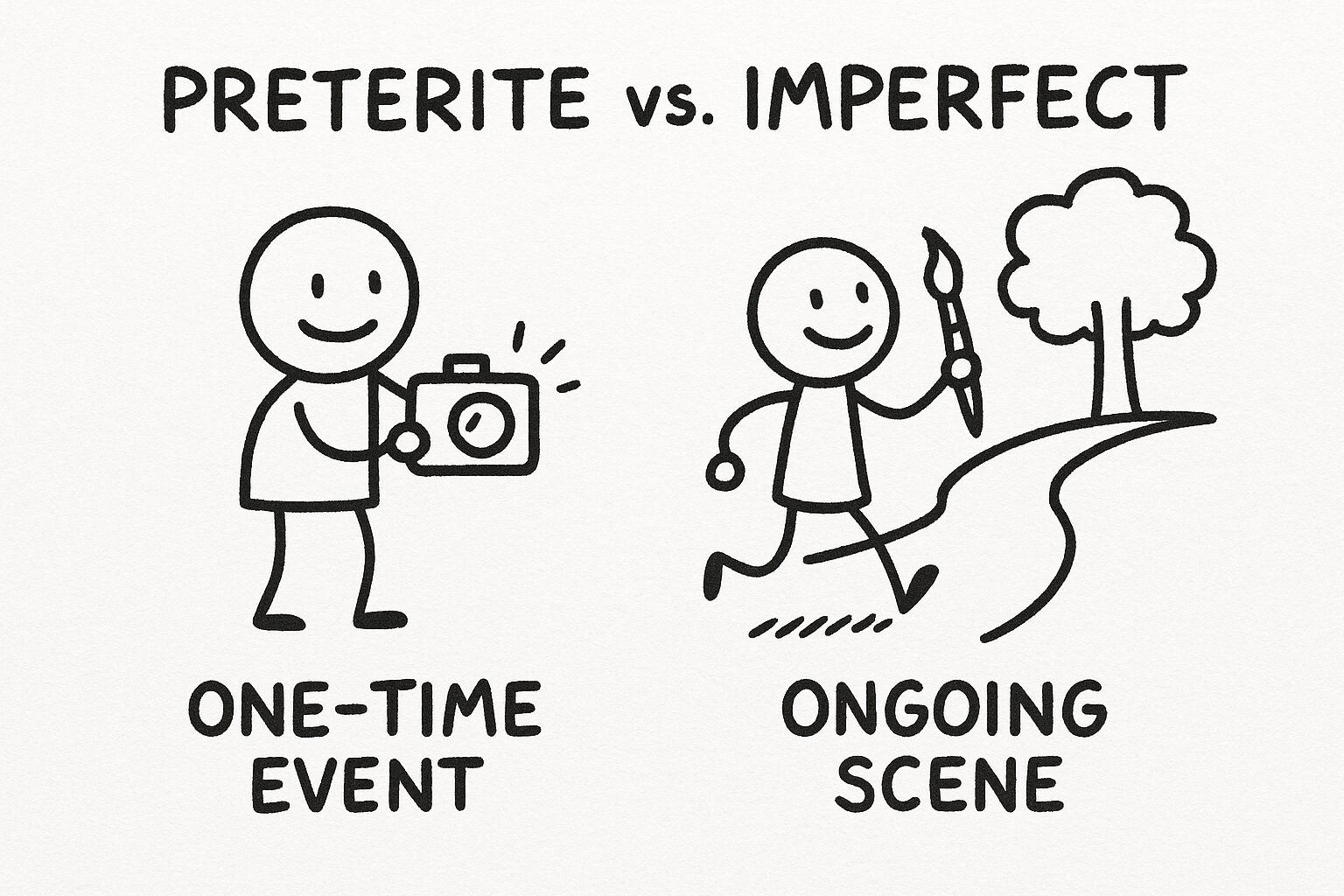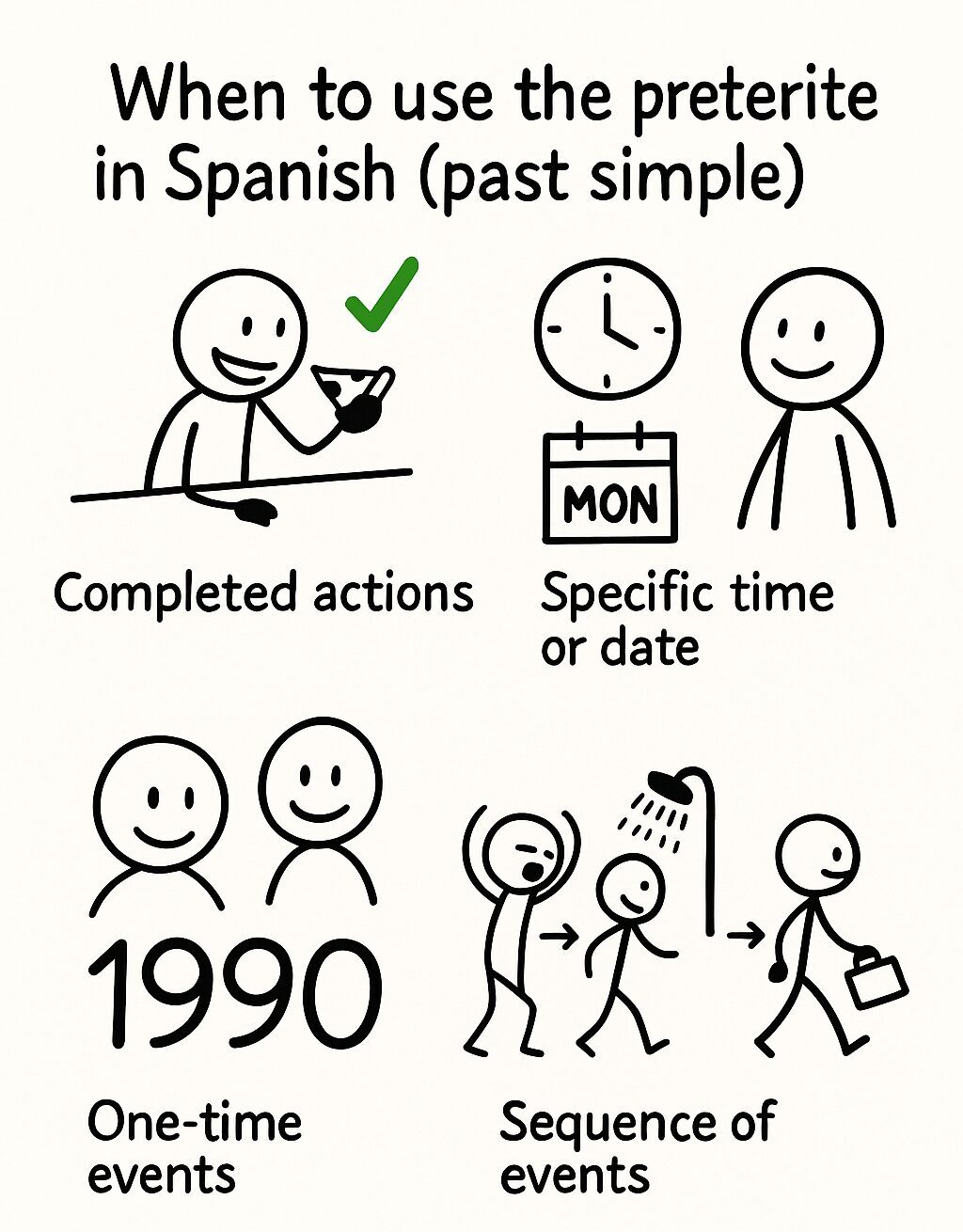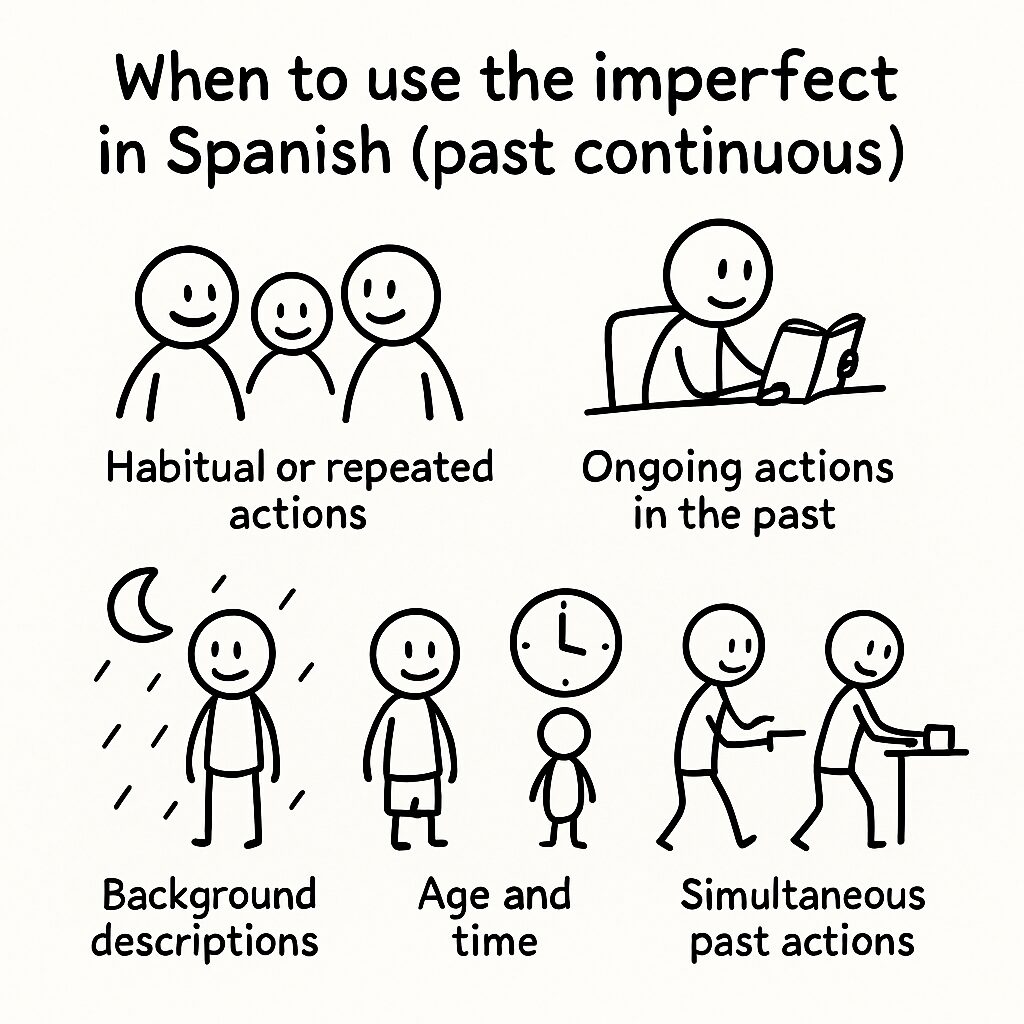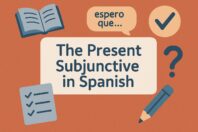Preterite vs. Imperfect Spanish: Everything You Need To Know
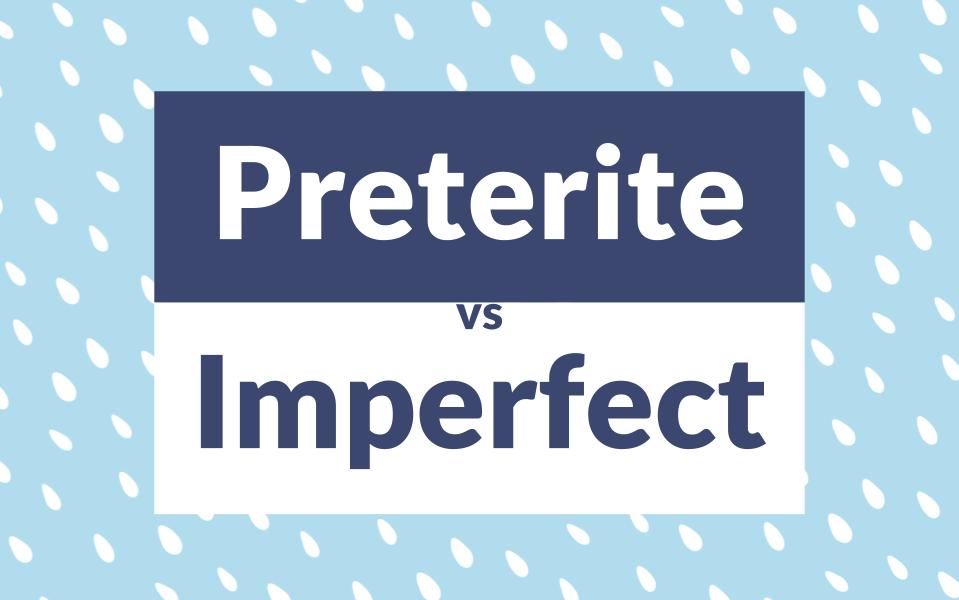
Get our free email course, Shortcut to Conversational.
Have conversations faster, understand people when they speak fast, and other tested tips to learn faster.
More infoIf you’re learning Spanish past tenses, you’ll quickly run into the preterite vs. imperfect contrast. For example, when talking about something you ate yesterday, should you say ayer comí or ayer comía? At first, questions like this can feel like a showdown between two tricky grammar rules, but don’t worry.
In this guide, we’ll break it down in simple terms so you’ll know exactly when to use each one. By the end, the preterite and the imperfect will make perfect sense. Let’s dive in!
What’s the difference between the preterite and imperfect in Spanish?
Think of the preterite as a way to talk about something that happened once, and the imperfect as a way to describe something that was happening or used to happen.
Both the preterite and imperfect are ways to talk about the past in Spanish, but they express different aspects of the past.
- The preterite is like a snapshot: it talks about specific, completed actions or events that happened at definite times.
- The imperfect is more like a video or background music: it describes ongoing or habitual actions, background details, or how things used to be.
In other words, the preterite tells you what happened (and that it’s over), while the imperfect sets the scene or tells you what was going on.
Example
Think of a past trip to the park.
If you say “I walked to the park” in Spanish (caminé al parque), you’d use the preterite because it’s a one-time completed action.
But if you describe “I used to walk to the park every afternoon” (Caminaba al parque cada tarde), you’d use the imperfect, because it’s talking about a repeated, habitual action in the past.
When to use the preterite in Spanish (past simple)
The Spanish preterite tense (el pretérito, sometimes called pasado simple) is your go-to for talking about completed actions in the past.
If something happened once, or it had a clear beginning and end, or it was a specific event, the preterite is probably the tense you need. Here are the most common situations for using the preterite:
- Completed actions: Use preterite for actions that are done and over with. If you can put a mental checkmark on it, it’s probably preterite.
- Example: Ayer comí pizza. – “Yesterday I ate pizza.” (It happened, it’s finished.)
- Specific time or date: If the sentence mentions a specific time, date, or period when something occurred, choose preterite.
- Example: El lunes pasado visitamos a la abuela. – “Last Monday we visited grandma.” (It happened on a specific day.)
- One-time events or single occurrences: Even without a time word, if you imply “this happened once,” use preterite.
- Example: Juan nació en 1990. – “Juan was born in 1990.” (Birth is a one-time event.)
- Sequence of events: If you’re narrating a sequence or list of past events that move the story forward (“this happened, then that happened”), those events will be in preterite.
- Example: Me desperté, me duché, y salí a trabajar. – “I woke up, took a shower, and left for work.” (A series of completed actions.)
In essence, use the preterite tense whenever you’re talking about something that occurred and was completed in the past. It answers the question “What happened?” with a clear endpoint.
When to use the imperfect in Spanish (past continuous)
The Spanish imperfect tense (el imperfecto) is used for descriptions and ongoing situations in the past.
Think of it as the tense for telling stories about how things were, or what used to happen. Common situations for the imperfect include:
- Habitual or repeated actions: If something happened regularly or used to happen over a period of time, use the imperfect.
- Example: Cuando era niño, jugaba con mis amigos todos los días. – “When I was a kid, I played with my friends every day.” (This was a habitual action, not one specific day.)
- Ongoing actions in the past: Use imperfect for an action that was in progress at a certain time, without focusing on when it started or ended. This is like the English “was/were … -ing.”
- Example: Ella leía un libro. – “She was reading a book.” (We don’t know when she started or finished – it’s an ongoing background action.)
- Background descriptions: If you’re setting the scene in the past – describing the weather, the scenery, how someone felt, or what things looked like – the imperfect is perfect!
- Example: La noche estaba oscura y hacía frío. – “The night was dark and it was cold.” (Description of a scene in the past.)
- Age and time: Talking about someone’s age in the past, or telling the time in the past? Always use imperfect for these cases.
- Example: Tenía 5 años en 2005. – “I was 5 years old in 2005.” (Age in the past – use imperfect.)
- Example: Eran las ocho de la noche. – “It was 8 PM.” (Telling time in the past – use imperfect.)
- Simultaneous past actions: If two things were happening at the same time in the past (often connected by mientras = “while”), you’ll typically use the imperfect for both, or imperfect for the ongoing actions and preterite for an interrupting action.
- Example: Yo cocinaba mientras mi hermano hacía la tarea. – “I was cooking while my brother was doing homework.” (Both ongoing, so both imperfect.)
In short, choose the imperfect whenever you’re describing how things were, or talking about repeated/continuous actions in the past without focusing on their start or end. It sets the background and answers “What was going on back then?”
Preterite vs. imperfect trigger words
While you don’t want to rely only on keywords, they can really help beginners figure out when to use preterite vs imperfect. Here are some common trigger words and phrases for each tense:
Preterite trigger words (specific past points in time)
- ayer (yesterday)
- anoche (last night)
- el otro día (the other day)
- la semana pasada (last week)
- el año pasado (last year)
- hace [tiempo] (… ago, e.g. hace dos días = two days ago)
- una vez (once)
- de repente (suddenly)
Imperfect trigger words (habitual or vague time frames)
- siempre (always)
- a menudo (often)
- generalmente (generally)
- cada día/semana/año (every day/week/year)
- todos los días (every day)
- antes (before)
- de niño/a (as a child)
- en aquellos tiempos (in those times)
- mientras (while)
These phrases suggest ongoing or repeated past scenarios, which align with the imperfect tense.
For example:
- Ayer fuimos a la playa. (“Yesterday we went to the beach.” – preterite, because ayer signals a specific completed day in the past.)
- Todos los veranos íbamos a la playa. (“Every summer we used to go to the beach.” – imperfect, because todos los veranos implies a recurring routine.)
Preterite vs imperfect endings (conjugation cheat sheet)
You’ll see that the imperfect is actually easier in terms of conjugation (only a couple of patterns, and just a few irregulars), while the preterite has more changes to learn.
Here’s a quick rundown of preterite vs imperfect endings for regular verbs, plus some key irregular verbs.
Regular verb endings in the preterite
Spanish verbs in the infinitive end in -ar, -er, or -ir, and the preterite uses specific endings for each group. For -AR verbs, the preterite endings are a little different from -ER/-IR verbs. Let’s use examples to see them:
Preterite endings for -AR verbs (e.g., hablar – “to speak”)
| Person | Ending | Example hablar (preterite) |
| yo (I) | -é | hablé (I spoke) |
| tú (you, informal) | -aste | hablaste (you spoke) |
| él/ella/usted (he/she/you formal) | -ó | habló (he/she/you spoke) |
| nosotros/nosotras (we) | -amos | hablamos (we spoke) |
| vosotros/vosotras (you all, Spain) | -asteis | hablasteis (you all spoke) |
| ellos/ellas/ustedes (they/you all) | -aron | hablaron (they/you all spoke) |
Preterite endings for -ER and -IR verbs (e.g., comer – “to eat”, vivir – “to live”)
| Person | Ending | Example comer (preterite) |
| yo (I) | -í | comí (I ate) |
| tú (you, informal) | -iste | comiste (you ate) |
| él/ella/usted | -ió | comió (he/she/you ate) |
| nosotros/nosotras | -imos | comimos (we ate) |
| vosotros/vosotras | -isteis | comisteis (you all ate) [Spain] |
| ellos/ellas/ustedes | -ieron | comieron (they/you all ate) |
Important spelling note for the preterite (yo form)
In the yo form of the preterite, some verbs change their spelling slightly to keep the pronunciation the same as in the infinitive.
- -car verbs (like buscar): c → qu before “é” → buscar → busqué (so it still sounds like “bus-KÉ”, not “bus-É”).
- -gar verbs (like jugar): g → gu before “é” → jugar → jugué (“hoo-GÉ” sound stays).
- -zar verbs (like almorzar): z → c before “é” → almorzar → almorcé (so it sounds like “al-mor-SÉ”, not “al-mor-ZÉ”).
These spelling tweaks don’t change the sound, they’re just to keep Spanish pronunciation rules consistent.
Regular verb endings in the imperfect
Good news: the imperfect tense is much more straightforward!
All -ER and -IR verbs share one set of endings, and -AR verbs have their own single set of endings. Here they are, with examples:
Imperfect Endings for -AR Verbs (e.g. hablar – “to speak”):
| Person | Ending | Example hablar (imperfect) |
| yo (I) | -aba | hablaba (I was speaking / I used to speak) |
| tú (you, informal) | -abas | hablabas (you used to speak) |
| él/ella/usted | -aba | hablaba (he/she/you used to speak) |
| nosotros/nosotras | -ábamos | hablábamos (we used to speak) |
| vosotros/vosotras | -abais | hablabais (you all used to speak) [Spain] |
| ellos/ellas/ustedes | -aban | hablaban (they/you all used to speak) |
Imperfect Endings for -ER / -IR Verbs (e.g. comer – “to eat”, vivir – “to live”):
| Person | Ending | Example comer (imperfect) |
| yo (I) | -ía | comía (I was eating / used to eat) |
| tú (you, informal) | -ías | comías (you were eating) |
| él/ella/usted | -ía | comía (he/she/you were eating) |
| nosotros/nosotras | -íamos | comíamos (we were eating) |
| vosotros/vosotras | -íais | comíais (you all were eating) [Spain] |
| ellos/ellas/ustedes | -ían | comían (they/you all were eating) |
Easy, right?
A few key irregulars to know
Good news first: the imperfect only has three irregular verbs. That’s it! 🎉
- ir (to go) → iba, ibas, iba, íbamos, ibais, iban
- ser (to be) → era, eras, era, éramos, erais, eran
- ver (to see) → veía, veías, veía, veíamos, veíais, veían
Everything else in the imperfect plays by the regular rules.
The preterite, on the other hand, likes to keep things interesting with more irregulars and stem changes. Start with these common ones:
- ser/ir (same forms) → fui, fuiste, fue, fuimos, fuisteis, fueron
- hacer → stem hic- (hizo in él/ella)
- tener → stem tuv-
- estar → stem estuv-
- decir → stem dij- (dijeron for ellos)
Here is the conjugation for these:
| Person | ser/ir | hacer | tener | estar | decir |
| yo | fui | hice | tuve | estuve | dije |
| tú | fuiste | hiciste | tuviste | estuviste | dijiste |
| él/ella/usted | fue | hizo | tuvo | estuvo | dijo |
| nosotros/nosotras | fuimos | hicimos | tuvimos | estuvimos | dijimos |
| vosotros/vosotras | fuisteis | hicisteis | tuvisteis | estuvisteis | dijisteis |
| ellos/ellas/ustedes | fueron | hicieron | tuvieron | estuvieron | dijeron |
Example: Fui al mercado (I went to the market) / Tuve un día ocupado (I had a busy day).
There are more, but these will cover a lot of everyday situations. Many share the same special endings (-e, -iste, -o, -imos, -ieron), so once you know the pattern, you’ll spot them easily.
Conclusion
Now you’ve learned the essentials of preterite vs. imperfect in Spanish in a simple, approachable way.
Remember, the preterite is your “event” tense and the imperfect is your “background” tense. For example:
Yo cocinaba cuando sonó el teléfono.
(Background = imperfect, interruption = preterite)
To make it even easier, follow this quick decision tree:
- Can I count it or put it on a timeline? → Preterite
- Was it happening or used to happen? → Imperfect
- Did something interrupt something else? → Background = Imperfect, Interrupter = Preterite
With these tips, trigger words, and everyday practice (like talking about your childhood or your day yesterday), choosing the correct past tense will soon feel natural.
